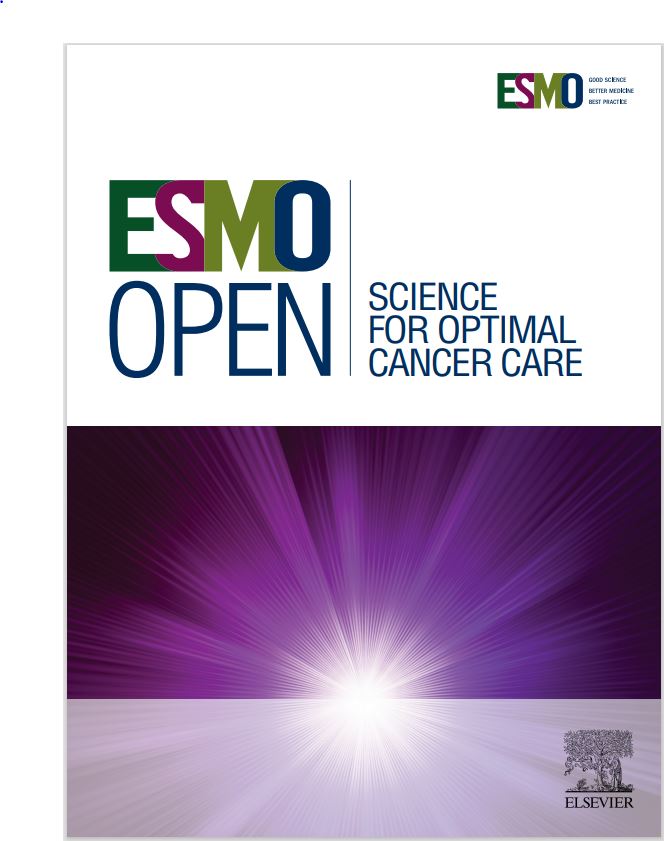Prevalence and clinical impact of germline pathogenic variants in breast cancer: a descriptive large single-center study
IF 7.1
2区 医学
Q1 ONCOLOGY
引用次数: 0
Abstract
Background
Germline (likely) pathogenic variants (PVs) are identified in 5%-10% of patients with breast cancer (BC) and play a critical role in guiding clinical management, including the use of targeted therapies such as poly (ADP-ribose) polymerase (PARP) inhibitors (PARPi). High-risk genes such as BRCA1, BRCA2, and PALB2, and moderate-risk genes such as CHEK2 and ATM, influence BC risk and treatment decisions. This study evaluates the prevalence and clinical impact of PVs in a large consecutive cohort.
Materials and methods
A retrospective analysis was conducted on 912 individuals with BC who underwent germline testing at the Hospital Clinic of Barcelona from 2016 to 2023. Genetic testing for 14 BC and Lynch syndrome genes was carried out using the TruSight Hereditary Cancer Panel. Statistical analyses were carried out to assess associations between germline results and clinical characteristics, including eligibility for PARPi therapy.
Results
Of the 912 individuals, 129 (14.1%) had a PV, with BRCA2 (31.8%) and BRCA1 (24%) being the most frequently altered genes. Additionally, 16.2% carried variants of uncertain significance, most commonly in ATM and BRCA2 genes. Patients with PV were younger compared with PV-negative individuals (median age: 43.5 versus 48.2 years, P = 0.006), more likely to have bilateral BC (13.3% versus 5.8%, P = 0.002), and more frequently diagnosed with triple-negative BC (TNBC; 28.7% versus 20.8%, P = 0.046). Of those with PVs, 39.1% completed a bilateral mastectomy, 36.7% had a risk-reducing salpingo-oophorectomy, and 22.7% had both surgeries. PV detection was associated with higher stages at diagnosis (stage IV: 13.0% versus 5.9%, P < 0.001). In the metastatic cohort, 12.9% received PARPi therapy, with 80.7% harboring BRCA1/2 PVs. In early BC, 13.1% met the criteria for adjuvant PARPi.
Conclusions
The identification of germline PVs significantly influences surgical decisions and systemic therapies. Genetic testing for patients with BC optimizes care, particularly in selecting candidates for PARPi in both early and advanced BC, improving management and prevention strategies.
乳腺癌种系致病变异的患病率和临床影响:一项描述性大型单中心研究
生殖系(可能的)致病变异(pv)在5%-10%的乳腺癌(BC)患者中被发现,并在指导临床管理中发挥关键作用,包括使用靶向治疗,如聚(adp -核糖)聚合酶(PARP)抑制剂(PARPi)。高危基因如BRCA1、BRCA2和PALB2,以及中危基因如CHEK2和ATM,影响BC的风险和治疗决策。本研究在一个大型连续队列中评估pv的患病率和临床影响。材料与方法对2016年至2023年在巴塞罗那医院诊所接受生殖系检测的912例BC患者进行回顾性分析。使用TruSight遗传癌症小组对14个BC和Lynch综合征基因进行基因检测。进行统计分析以评估生殖系结果与临床特征之间的关系,包括PARPi治疗的资格。结果在912例个体中,129例(14.1%)有PV,其中BRCA2(31.8%)和BRCA1(24%)是最常见的改变基因。此外,16.2%的人携带不确定意义的变异,最常见的是ATM和BRCA2基因。与PV阴性个体相比,PV患者更年轻(中位年龄:43.5岁对48.2岁,P = 0.006),更容易患双侧BC(13.3%对5.8%,P = 0.002),更常被诊断为三阴性BC (TNBC;28.7%对20.8%,P = 0.046)。在pv患者中,39.1%的人完成了双侧乳房切除术,36.7%的人进行了降低风险的输卵管卵巢切除术,22.7%的人进行了两种手术。PV检测与诊断时分期较高相关(IV期:13.0% vs 5.9%, P <;0.001)。在转移性队列中,12.9%的患者接受了PARPi治疗,其中80.7%的患者携带BRCA1/2 pv。在BC早期,13.1%符合佐剂PARPi标准。结论生殖系pv的识别对手术决策和全身治疗有重要影响。对BC患者进行基因检测可以优化护理,特别是在早期和晚期BC患者中选择PARPi候选药物,改善管理和预防策略。
本文章由计算机程序翻译,如有差异,请以英文原文为准。
求助全文
约1分钟内获得全文
求助全文
来源期刊

ESMO Open
Medicine-Oncology
CiteScore
11.70
自引率
2.70%
发文量
255
审稿时长
10 weeks
期刊介绍:
ESMO Open is the online-only, open access journal of the European Society for Medical Oncology (ESMO). It is a peer-reviewed publication dedicated to sharing high-quality medical research and educational materials from various fields of oncology. The journal specifically focuses on showcasing innovative clinical and translational cancer research.
ESMO Open aims to publish a wide range of research articles covering all aspects of oncology, including experimental studies, translational research, diagnostic advancements, and therapeutic approaches. The content of the journal includes original research articles, insightful reviews, thought-provoking editorials, and correspondence. Moreover, the journal warmly welcomes the submission of phase I trials and meta-analyses. It also showcases reviews from significant ESMO conferences and meetings, as well as publishes important position statements on behalf of ESMO.
Overall, ESMO Open offers a platform for scientists, clinicians, and researchers in the field of oncology to share their valuable insights and contribute to advancing the understanding and treatment of cancer. The journal serves as a source of up-to-date information and fosters collaboration within the oncology community.
 求助内容:
求助内容: 应助结果提醒方式:
应助结果提醒方式:


